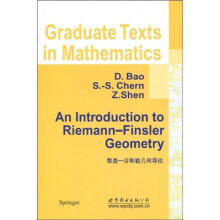Preface
Acknowledgments
PART ONE
Finsler Manifolds and Their Curvature
CHAPTER 1
Finsler Manifolds and
the Fundamentals of Minkowski Norms
1.0 Physical Motivations
1.1 Finsler Structures: Definitions and Conventions
1.2 Two Basic Properties of Minkowski Norms
1.2 A. Enlers Theorem
1.2 B. A Fundamental Inequality
1.2 C. Interpretations of the Fundamental Inequality .
1.3 Explicit Examples of Finsler Manifolds
1.3 A. Minkowski and Locally Minkowski Spaces
1.3 B. Riemannian Manifolds
1.3 C. Randers Spaces
1.3 D. Berwald Spaces
1.3 E. Finsler Spaces of Constant Flag Curvature
1.4 The Fundamental Tensor and the Cartan Tensor
Referenees for Chapter 1
CHAPTER 2
The Chern Connection
2.0 Prologue
2.1 The Vector Bundleand Related Objects
2.2 Coordinate Bases Versus Special Orthonormal Bases
2.3 The Nonlinear Connection on the Manifold TM \O
2.4 The Chern Connection on
2.5 Index Gymnastics
2.5 A. The Slash (..-)s and the Semicolon (...);s
2.5 B. Covariant Derivatives of the Fundamental Tensor g
2.5 C. Covariant Derivatives of the Distinguished
References for Chapter 2
CHAPTER 3
Curvature and Schurs Lemma
3.1Conventions and the hh-, hv-, w-curvatures
3.2First Bianchi Identities from Torsion Freeness
3.3Formulas for R and P in Natural Coordinates
3.4First Bianchi Identities from "Almost" g-compatibility
3.4 A. Consequences from the
3.4 B. Consequences from the
3.4 C. Consequences from the
3.5Second Bianchi Identities
3.6Interchange Formulas or Ricci Identities
3.7Lie Brackets among the
Oy
3.8Derivatives of the Geodesic Spray Coefficients
3.9The Flag Curvature
3.9 A. Its Definition and Its Predecessor
3.9 B. An Interesting Family of Examples of Numata Type
3.10 Schurs Lemma
References for Chapter 3
CHAPTER 4
Finsler Surfaces and
a Generalized Gauss-Bonnet Theorem
4.0 Prologue
4.1 Minkowski Planes and a Useful Basis
4.1 A. Runds Differential Equation and Its Consequence
4.1 B. A Criterion for Checking Strong Convexity
4.2 The Equivalence Problem for Minkowski Planes
4.3 The Berwald Frame and Our Geometrical Setup on SM
4.4 The Chern Connection and the Invariants I, J, K
4.5 The Riemannian Arc Length of the Indicatrix
4.6 A Gauss-Bonnet Theorem for Landsberg Surfaces
References for Chapter 4
PART TWO
Calculus of Variations and Comparison Theorems
CHAPTER 5
Variations of Arc Length,
Jacobi Fields, the Effect of Curvature
5.1 The First Variation of Arc Length
5.2 The Second Variation of Arc Length
5.3 Geodesics and the Exponential Map
5.4 Jacobi Fields
5.5 How the Flag Curvatures Sign Influences Geodesic Rays
References for Chapter 5
CHAPTER 6
The Gauss Lemma and the Hopf-Rinow Theorem
6.1 The Gauss Lemma
6.1 A. The Gauss Lemma Proper
6.1 B. An Alternative Form of the Lemma
6.1 C. Is the Exponential Map Ever a Local Isometry?
6.2 Finsler Manifolds and Metric Spaces
6.2 A. A Useful Technical Lemma
6.2 B. Forward Metric Balls and Metric Spheres
6.2 C. The Manifold Topology Versus the Metric Topology .
6.2 D. Forward Cauchy Sequences, Forward Completeness .
6.3 Short Geodesics Are Minimizing
6.4 The Smoothness of Distance Functions
6.4 A. On Minkowski Spaces
6.4 B. On Finsler Manifolds
6.5 Long Minimizing Geodesics
6.6 The Hopf-Rinow Theorem
References for Chapter 6
CHAPTER 7
The Index Form and the Bonnet-Myers Theorem
7.1 Conjugate Points
7.2 The Index Form"
7.3 What Happens in the Absence of Conjugate Points?
7.3 A. Geodesics Are Shortest Among "Nearby" Curves ...
7.3 B. A Basic Index Lemma
7.4 What Happens If Conjugate Points Are Present?
7.5 The Cut Point Versus the First Conjugate Point
7.6 Ricci Curvatures
7.6 A. TheRicci Scalar Ric and the Ricci Tensor Ricij
7.6 B. The Interplay between Ric and Ricij
7.7 The Bonnet-Myers Theorem
References for Chapter 7
CHAPTER 8
The Cut and Conjugate Loci, and Synges Theorem
8.1 Definitions
8.2 The Cut Point and the First Conjugate Point
8.3 Some Consequences of the Inverse Function Theorem
8.4 The Manner in WhichandDepend on y
8.5 Generic Properties of the Cut Locus
8.6 Additional Properties of Cutx When M Is Compact
8.7 Shortest Geodesics within Homotopy Classes
8.8 Synges Theorem
References for Chapter 8
CHAPTER 9
The Cartan-Hadamard Theorem and
Rauchs First Theorem
9.1 Estimating the Growth of Jacobi Fields
9.2 When Do Local Diffeomorphisms Become Covering Maps? .
9.3 Some Consequences of the Covering Homotopy Theorem ...
9.4 The Cartan-Hadamard Theorem
9.5 Prelude to Rauchs Theorem
9.5 A. Transplanting Vector Fields
9.5 B. A Second Basic Property of the Index Form
9.5 C. Flag Curvature Versus Conjugate Points
9.6 Rauchs First Comparison Theorem
9.7 Jacobi Fields on Space Forms
9.8 Applications of Rauchs Theorem
References for Chapter 9









 缺书网
缺书网 扫码进群
扫码进群